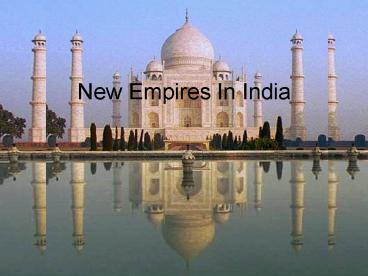New Empires In India - PowerPoint PPT Presentation
1 / 15
Title:
New Empires In India
Description:
... is considered to be the greatest ruler in Indian history ... After a period of bloody conquest, Asoka converted to Buddhism and tried to rule kindheartedly ... – PowerPoint PPT presentation
Number of Views:3033
Avg rating:3.0/5.0
Title: New Empires In India
1
New Empires In India
2
India After Alexander
- Alexander briefly conquered Northwest India in
327 BC - Briefly united and spread Greek culture
3
The Mauryan Dynasty
- Alexanders death left a void in the region
- Chandragupta Maurya pushed out the Greek
occupying forces to establish the first Indian
Empire in 324 BC - The Mauryan Empire thrived on centralized power
4
The Mauryan Empire
- The king had a large army and a secret police
- Region was divided into provinces and ruled by
appointed governors - Provinces were divided into districts ruled by
appointed officials
5
The Mauryan Empire
- Chandragupta Maurya retired and turned over rule
to his son, Bindusara - Bindusara ruled for a short time and turned over
rule to his son, Asoka - Asoka ruled from 269 to 232 BC and is considered
to be the greatest ruler in Indian history - After a period of bloody conquest, Asoka
converted to Buddhism and tried to rule
kindheartedly
6
Asokas Rule
- Set up hospitals for people and animals
- Tired to convert people to Buddhism
- Trade and industry flourished
- After Asokas death in 232 BC the Mauryan Empire
declined
7
Trade in the Mauryan Dynasty
- India became one of the most advanced trading
civilizations of the ancient world - India became a crossroads for trade between China
and the Mediterranean world - Exports spices, salt, perfumes, jewels,
textiles, ivory - Imports gold, tin, lead, wine
8
India after the Mauryan Dynasty
- In the first century AD nomadic warriors seized
power and established the Kushan kingdom - Controlled Northern India while the rest of India
remained in conflict - Controlled trade routes between the Roman Empire
and China to become very wealthy - The Silk Road
9
The Silk Road
- The connection between the Mediterranean world
and India was widespread - Resulted in the establishment of Roman
settlements along the Indian coast - China remained the main supplier of silk to the
Mediterranean world for centuries
10
The Silk Road
11
The Kingdom of the Guptas
- The Kushan Kingdom came to an end in the 3rd
century AD - In 320 a local prince, Chandragupta, established
a new empire in the Ganges Valley - His son Samudragupta expanded the empire into the
surrounding areas - The kingdom of the Guptas became the dominant
political force in Northern India
12
The Kingdom of the Guptas
- The Guptas created a new age of Indian
civilization - Actively engaged in trade with China, Southeast
Asia, and the Mediterranean - Prosperous cities developed along trade routes
- Religious pilgrims spread culture and technology
13
The Kingdom of the Guptas
- Prosperity from trade aided the growth of the
state - Trade was regulated by the government
- Gold and silver made the ruling class very
wealthy
14
Decline of the Guptas
- By the 5th century AD, invasions by the Huns
gradually reduced the strength of the empire - Harsa briefly revived the empire in the 7th
century - After his death the empire of the Guptas fell
apart
15
The World of Indian Culture
- The reign of Chandragupta 2 is seen as the high
point of Indian culture - India has made great contributions in literature,
science, sculpture, art, and medicine

